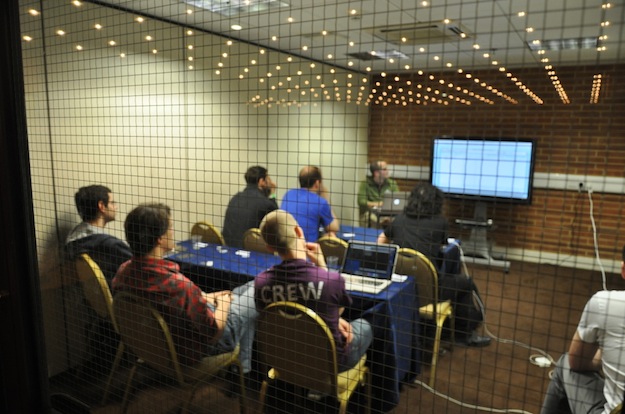When an organisation tries to tackle the “collaboration and automated reporting problem“, one of the early decisions to make is whether they should try to build a solution in-house or use an off-the-shelf collaboration tool.
Of course, this is not an easy decision to make and there are a lot of factors involved including:
- Your firm’s size and resources
- Cost (in-house != free)
- The risks involved
But before we begin discussing these factors, it will be useful to get a quick overview what’s really involved in creating a software tool.
The challenge of building a software tool
What we are talking about here is building a solid back-office tool, something your business can rely on, not a quick Python script to parse Nmap output.
My background is in information security and electrical engineering, but I’ve written a lot of software, from small funny side projects, to successful open source tools and commercial products and services.
I’m neither a software engineering guru nor an expert in software development theory (I can point you in the right direction though), but building a software tool involves a few more steps than just “coding it”. For starters:
- Capture requirements
- Design the solution
- Create a test plan
- Develop
- Document
- Maintain
- Improve
- Support your users
- …
The steps will vary a little depending on your choice of software development methodology, but you get the idea.
If one of the steps is missing the full thing falls apart. For instance, say someone forgets to ‘document’ a new tool. Whoever wants to use the tool and doesn’t have direct access to the developer (e.g. a new hire 8 months down the line) is stuck. Or if there is no way to track and manage feature requests and improvements, the tool will become outdated pretty quickly.
With this background on what it takes to successfully build a solid software tool, lets consider some of the factors that should play a role in deciding whether to go the in-house route or not.
Your firm’s size and resources
How many resources can your firm invest in this project? Google can put 100 top-notch developers to work on an in-house collaboration tool for a full quarter and the financial department won’t even notice.
If you are a small pentesting firm, chances are you don’t have much in terms of spare time to spend on pet projects. As the team grows, you may be able to work some gaps in the schedule and liberate a few resources though. This could work out. However, you have to consider that not only will you need to find the time to create the initial release of the tool but also you’ll need to be able to find the resources down the line to maintain, improve and support it. The alternative is to bring a small group of developers on payroll to churn back-office tools (I’ve seen some mid- and large-size security firms that successfully pulled this off). However this is a strategic decision which comes with a different set of risks (e.g. how will you keep your devs motivated? What about training/career development for them? Do you have enough back-end tools to write to justify the full salary of a developer every month?).
Along the same lines, if you’re part of the internal security team of an organisation that isn’t focussed on building software, chances are you’ll have plenty in your plate already without having to add software project management and delivery to it.
Cost (in-house != free)
There is often the misconception that because you’re building it in-house, you’re getting it for free. At the end of the day whoever is writing the tool is going to receive the same salary at the end of the month. If you get the tool built at the same time, that’s like printing your own money!
Except… it isn’t. The problem with this line of reasoning is the at the same time part. Most likely the author is being paid to perform a different job, something that’s revenue-generating and has an impact in the bottom line. If the author stops delivering this job, all that revenue never materialises.
Over the years, I’ve seen this scenario play out a few times:
– Manager: How long is it going take?
– Optimistic geek: X hours, Y days tops
– Manager: Cool, do it!
What is missing from the picture is that it is not enough to set aside a few hours for “coding it”, you have to allocate the time for all the tasks involved in the process. And more often than not Maintaining and Improving are going to take the lion’s share of the resources required to successfully build the tool (protip: when in doubt estimating a project: sixtoeightweeks.com).
One of the tasks that really suffers when going the in-house route is Support: if something breaks in an unexpected way, who will fix it? Will this person be available when it breaks or there is a chance he’ll be on-site (or abroad) for a few weeks before the problem can be looked into?
Your firm’s revenue comes from your client work not from spending time and resources working on your back-end systems. The fact that you can find some time and resources to build the first release of a given tool, doesn’t mean that maintaining, supporting and improving your own back-end tools will make economic sense.
The risks of in-house development
There are a few risks involved in the in-house approach that should be considered. For instance, what happens when your in-house geek, the author of the tool, decides to move on and leaves the company? Can someone maintain and improve the old system or are you back to square one? All the time and resources invested up to that point can be lost if you don’t find a way to continue maintaining the tool.
Different developers have different styles and different preferences for development language, technology stack and even source code management system. Professional developers (those that work for a software vendor developing software as their main occupation) usually agree on a set of technologies and practices to be used for a given project, meaning that new people can be brought on board or leave the team seamlessly. Amateur developers (those that like building stuff but don’t do it as their main occupation) have the same preferences and biases as the pros and they are happy to go with them without giving them a second though as they don’t usually have to coordinate with others. Normally, they won’t invest enough time creating documentation or documenting the code because at the end of the day, they created it from scratch and know it inside out (of course 6 months down the line, they’ll think it sucks). Unfortunately this means that the process of handing over or taking ownership of a project created in this way will be a lot more complicated.
When building your own back-end systems you have to think: who is responsible for this tool? Another conversation I’ve seen a few times:
(the original in-house author of the tool just moved on to greener pastures)
– Manager: Hey, you like coding, will you take responsibility for this?
– Optimistic geek: Sure! But it’s Ruby, I’ll rewrite the entire thing from scratch in Python and we’ll be rolling in no time!
– Manager: [sigh]
If you are part of a bigger organisation that can make the long-term strategic commitment to build and maintain the tool then go ahead. If you don’t have all those resources to spare and are relying on your consultants to build and maintain back-end tools, be aware of the risks involved.
Conclusion: why does the in-house approach not always work?
The in-house development cycle of doom:
- A requirement for a new back-office tools is identified
- An in-house geek is nominated for the task and knocks something together.
- A first version of the tool is deployed and people get on with their business.
- Time passes, tweaks are required, suggestions are made, but something else always has priority on the creator’s agenda.
- Maybe after a few months, management decides to invest a few days from the creator’s time to work on a new version.
As you can imagine, this process is unlikely to yield optimum results. If building software tools is not a core competency of your business, you may be better served by letting a software development specialist help you out. Let them take care of Maintaining, Improving and Supporting it for you while you focus on delivering value to your clients.
Of course the other side of this coin is that if you decide to use a third-party tool, whoever you end up choosing has to be worthy of your trust:
- How long have they been in business?
- How many clients are using their solutions?
- How responsive is their support team?
These are just some of the highlights though, the topic is deep enough to warrant its own blog post.
tl; dr;
Going the in-house route may make sense for larger organisations with deeper pockets. They can either hire an internal development team (or outsource the work and have an internal project manager) or assign one or several in-house geeks to spend time creating and maintaing the tools. But remember: in-house != free.
Smaller teams and those starting up are usually better off with an off-the-shelf solution built by a solid vendor that is flexible and reliable. However, the solution needs to be easily extended/connected with other tools and systems to avoid any vendor lock-ins of your data.




